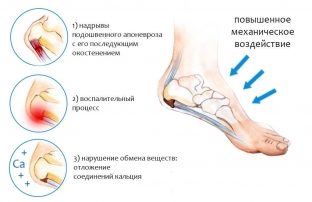The heel spur has a very wide and not very pleasant reputation, since the pain that this bone growth on the calcaneus delivers sometimes causes unbearable torment and even leads to disability, the patient's desire to walk on crutches, just not to touch the sore spot on foot. Treatment of the heel affected by the growth of the heel spur is carried out using different methods – from massage to surgical removal. It is important to explain to the patient that the heel spur is completely treatable and that easy walking without pain will be available to him at the end of therapy.
Special causes of heel spur growth
X-ray of the foot, performed when the patient complains of severe pain in the area of the calcaneal tuberosity, shows a bony growth that resembles a wedge or flower spike in shape. This growth usually appears on the plantar side of the calcaneal tuberosity or where the Achilles tendon attaches. This disease has an extremely high prevalence, especially among women over 40.
Probably, women's suffering about the development of a heel spur is due to the peculiarity of the structure of the female foot – weakness of the ligamentous apparatus and muscles. Other predisposing factors that accelerate the formation of a heel spur are:
- flat feet;
- overweight;
- arthritis;
- rheumatism;
- diseases of the venous system;
- age-related metabolic disorders in the body;
- prolonged stress on the foot (for athletes and those who have to work for a long time in a standing position).
Typical symptoms of a heel spur
In the process of growing a heel spur, there is usually no discomfort for the patient. They appear, in fact, due to the fact that the overgrown spike on the tubercle of the calcaneus begins to injure the surrounding tissues. When walking, other disorders join: the periosteum and synovial bag become inflamed, dystrophic changes occur in the surrounding tissues.
Externally, the symptoms of a heel spur are manifested as follows. First, heel pain occurs while walking. Then she becomes burning strong – patients compare it to the sensation of stepping on a hot, sharp nail. Moreover, the pains are especially strong in the morning after sleep, during the day they subside and return with an increase in the evening. Pain with a heel spur can become permanent, the patient cannot work, moves on crutches to relieve the sore leg at least a little.
The size of the heel spur has nothing to do with the strength of pain – the patient may suffer with a barely noticeable growth and have no complaints with a massive growth of the heel spur. When examining a sore heel, usually no noticeable violations are detected – sometimes swelling or callosity is slightly noticeable, it hurts the patient when squeezing the heel from the sides.
Conservative and surgical treatment of heel spurs
As a rule, the treatment of a heel affected by a heel spur is carried out conservatively: these are massages and physiotherapy exercises, laser and ultrasound therapy, shock wave therapy. In the absence of effect and the preservation of severe pain, drug blockade is used – drugs help to stop pain and eliminate inflammation. Treatment of the heel with the surgical method – heel spur removal is extremely rare if all other methods have failed.








Add a comment